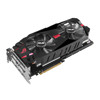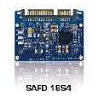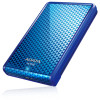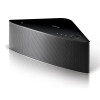
Now it is high time to start reviewing cards based on the NVIDIA GeForce3 but we mustn't forget the previous generation of graphics processors: the newest GPU GeForce3 is meant not to replace the chips released earlier but to become a head of the GeForce family.
That is why we will return to reviewing cards based on the GeForce2 MX or GTS when some interesting models appear.
As early as in February I studied the first video card from "new" Hercules - the 3D Prophet II Pro based on the GeForce2 Pro. Why "new"? I have already described what caused Hercules Computer to be bought by Guillemot. Since then Hercules, as a subdivision of this French concern, has started a new life.
Unfortunately, Hercules's cards are not cheap which has always frightened many dealers. ELSA's products are in a similar situation - they always cost more than products of Creative and ASUSTeK: the cost of Taiwanese and Singaporean products is much lower than that of European companies.
But during the last year the cost of some European cards, in particular ELSA's ones, was being reduced drastically (possibly due to the fact that the company started placing orders in Taiwan). Hercules has gotten into the similar situation.
So, today I invite you to get acquainted with three cards based on the widely known NVIDIA GeForce2 MX and GeForce2 GTS.
Cards
1. Hercules 3D Prophet II GTS 32 MBytes
The Hercules 3D Prophet II GTS 32 MBytes has an AGP x2/x4 interface, 32 MBytes DDR SGRAM located in 4 chips on the face side of the PCB.
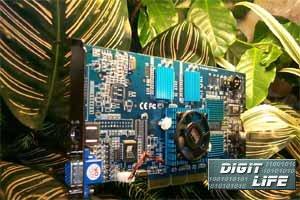

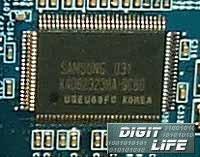
Samsung's memory chips with 6 ns access time (which corresponds to 166 (333) MHz) are installed here. As you can see many brand-name manufacturers have turned to using 4 64-MB modules (such SGRAM modules are produced usually by Samsung) instead of 8 32-MB chips (as a rule, from Infineon). On the rear panel of the card there are some blank spaces for memory modules. And this is intended not for a 64-MB model of the video card because the 3D Prophet II GTS 64 MBytes has a different design.
The card's design is much different from the reference one from NVIDIA, firstly, in the position of major components (for example, a block controlling the power supply distribution is located in the right part of the card, whereas on the reference card it is in the left part, next to the output circuits). Besides, a TV-out is mounted on the PCB, and not on a daughter card.
When the NVIDIA GeForce2 GTS appeared in the market a year ago, many companies, including Hercules, announced their products based on it. And it was strange to see heatsinks on memory modules. Of course, 166-MHz memory modules don't heat much and, therefore, don't require such cooling. And the numerous reviews of those cards showed that these heatsinks are useless for overclocking. That is why we are going to consider the blue heatsinks installed on the memory chips as a design feature.
The GPU is equipped with a usual cooler with a fan of blue color. The PCB itself is sky-blue. This color is a "calling card" of not only Guillemot, but also of Hercules now.
The TV-out has a S-Video connector and you can also find a S-Video-to-RCA adapter in the box, so that the TV-out feature is available for all users.
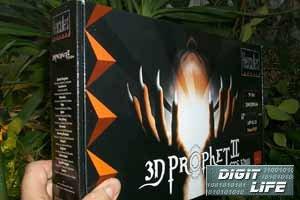
The card is shipped in a dark Retail-package with a traditional red pattern.
The box contains:
- User's Manual;
- CD with drivers,utilities and a DVD-player - PowerDVD;
- S-Video-to-RCA adapter.
Overclocking
The Hercules 3D Prophet II GTS 32 MBytes reached 240/200 (400) MHz. The overclocking results are impressive, it is nearly a record for 32 MBytes cards based on the GeForce2 GTS, though sometimes we managed to reach higher memory overclocking scores. Nevertheless, it is a very good achievement for Samsung's modules with 6 ns access time. As you know, the memory bandwidth is the worst bottleneck for the performance of such cards, that is why the overclocking of the GPU is not very important, though it may be vital for 16-bit color.
2. Hercules 3D Prophet II GTS 64 MBytes
The Hercules 3D Prophet II GTS 64 MBytes has an AGP x2/x4 interface, 64 MBytes DDR SDRAM located in 8 chips on the face side of the PCB.

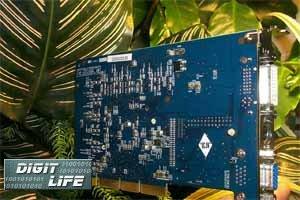
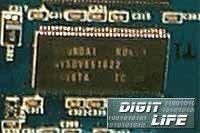
Hyundai's memory chips with 6 ns access time (unfortunately, after the disjointing of heat sinks the marking on the memory modules was illegible), which corresponds to 166 (333) MHz, are installed here. In this case Hercules uses a standard (for 64-MB cards of this class) memory set.
The design completely corresponds to the reference one from NVIDIA. It concerns both the position of major components and the mounting of a TV-out on the daughter card.
There is a DVI connector on the PCB and owners of monitors with digital interface can use this peculiarity of the given card.
The card is equipped with blue heatsinks. In this respect the card is very similar to the above-mentioned one.
The TV-out has a S-Video connector but a S-Video-to-RCA adapter is also present in the box.

The card is shipped in a Retail-package similar to the above one.
The box contains:
- User's Manual;
- CD with drivers, utilities and a DVD-player - PowerDVD;
- S-Video-to-RCA adapter.
Overclocking
The Hercules 3D Prophet II GTS 64 MBytes card worked stable at maximum of 210/190 (380) MHz. It is a very weak overclocking, many brand-name video cards can beat it easily. But maybe it is only an unsuccessful sample.
3. Hercules 3D Prophet II MX
The Hercules 3D Prophet II MX has an AGP x2/x4 interface, 32 MBytes SDR SDRAM located in 4 chips on the face side of the PCB.

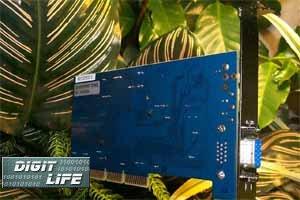
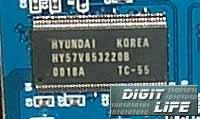
Hyundai's memory chips with 5.5 ns access time (which corresponds to 183 MHz) are installed here. The memory works exactly at this frequency which is an advantage of this video card as compared with other traditional GeForce2 MX ones.
The design of the card completely corresponds to the reference one from NVIDIA. Apart from the stylish blue color there are no peculiarities in the design of the card. The chip is equipped with a heatsink without a fan.
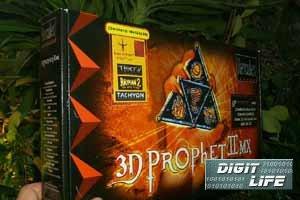
The card is shipped in a Retail-package.
The box includes:
- User's Manual;
- CD with drivers, utilities, and a DVD-player - PowerDVD;
Overclocking
With the Hercules 3D Prophet II MX we managed to reach a stable work at maximum of 225/215 MHz. It is a very good chipset overclocking result, but for 183-MHz memory modules the overclocking up to 215 MHz is very moderate.
Installation And Drivers
The test system configuration for the SUMA Platinum GeForce2 MX400:
- CPU - the Intel Pentium III 1000 MHz:
- The Chaintech 6OJV (i815) mainboard;
- RAM - 256 MBytes PC133;
- HDD - the IBM DPTA 20 GBytes;
- OS - Windows 98 SE;
- The ViewSonic P810 (21") and ViewSonic P817 (21") monitors.
The tests were carried out with 12.00 drivers from NVIDIA.
For comparison we have taken the results of the SIGMA Cyber5500 (GeForce2 MX) and SIGMA Cyber6000 (GeForce2 GTS).
Test Results
The 2D graphics quality is very decent, not worse than that of other brand-name cards. It concerns all three given video cards. Nevertheless, the 2D quality may depend on a definite sample.
Now we are going to estimate the performance of the card in 3D with id Software Quake3 v.1.17 - a game test showing the performance of the card in OpenGL using a standard demo-benchmark - demo002. This is quite enough to check whether these cards correspond to the performance level of the GeForce2 MX and GeForce2 GTS.
Quake3 Arena
demo002
The tests were carried out in two modes: Fast (shows the card's operation at 16-bit color) and High Quality (shows the card's operation at 32-bit color).
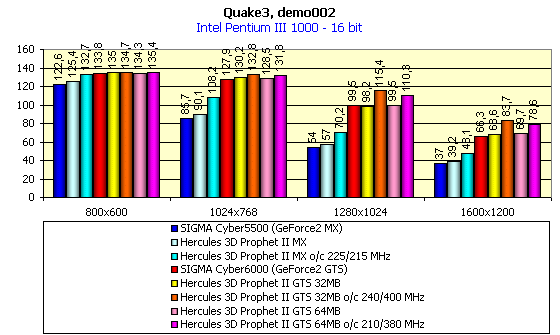
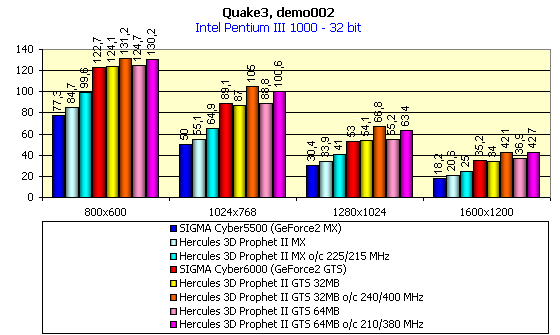
The results are not unexpected. The Hercules 3D Prophet II GTS 32 and 64 MBytes showed the performance normal for their class. The 64 MBytes model turned to be a bit faster at high resolutions, and the 3D Prophet II MX showed a bit higher speed than that of a common GeForce2 MX card due to a faster memory (183 against 166 MHz).
Overclocking of the 3D Prophet II GTS 32 MBytes has given a considerable speed gain, this also concerns the GeForce2 MX card, but the 3D Prophet II GTS 64 MBytes has got a moderate overclocking result.
Conclusion
- The Hercules 3D Prophet II GTS 32 and 64 MBytes showed an ordinary level of the GeForce2 GTS cards from top manufacturers. The implementation quality is very high, nothing to complain about.
- The Hercules 3D Prophet II MX demonstrated a bit higher performance than that of an average level of the GeForce2 MX cards, also having a good overclocking potential and perfect implementation quality.
- All these cards cost a little bit more than the competitors (except the Hercules 3D Prophet II MX), which may affect their popularity.
- It is worth noting that many manufacturers prefer installing cheap memory modules now. On the contrary, Hercules follows the principle of high quality memory modules. And even on the cheap Hercules 3D Prophet II MX we see Hyundai's memory.
Highs:
- Very good quality in 2D;
- Full conformity of speed characteristics with such of their class;
- Excellent implementation quality;
- TV-out and DVI support, S-Video-to-RCA adapters;
- DVD-player.
Lows:
- Overprice of the 3D Prophet II GTS;
- Scanty Retail-package without any game software.
Write a comment below. No registration needed!







